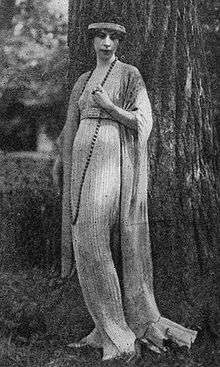Delphos gown
The Delphos gown is a finely pleated silk dress first created in about 1907 by French designer Henriette Negrin and her husband, Mariano Fortuny y Madrazo (1871–1949). They produced the gowns until about 1950.[1][2] It was inspired by, and named after, a classical Greek statue, the Charioteer of Delphi.[3] Since the 1970s, these gowns have been desirable and collectable pieces of vintage clothing, with one selling for a world record price of $10,000 in December 2001.[4]

History

Working out of a 13th-century Venetian palazzo, Fortuny, a Spanish-born artist turned textile designer, produced garments that the novelist Marcel Proust declared "faithfully antique but markedly original".[5][6] The "Delphos" was a deliberate reference to the chiton of ancient Greece and meant to be worn without undergarments, since the chiton was itself a form of underwear, a radical suggestion during the early years of the 20th century.[7]
Fortuny became famous for his pleated dresses, the "Delphos" and the related "Peplos".[8] The exact method of pleating was a closely guarded secret involving heat, pressure and ceramic rods, which has never been replicated.[7] On both types of dresses, glass Murano beads are strung on a silk cord along each side seam. The beads serve a functional purpose as well as being decorative, as they weigh down the lightweight silk of the garment to ensure a smooth fit enhancing the natural, uncorseted human form beneath.[9] The construction of the Delphos became its own decoration.[9] Although the "Delphos" eventually became formal wear, with Lauren Bacall wearing a vintage red Delphos to the 1978 Oscars,[10] it was originally intended as informal clothing or a tea gown for wearing solely in the privacy of the home.[9][11]
Delphos gowns were imported into Paris by the couturier Paul Poiret, and the fashion house Babani which sold them to actresses such as Eleonora Duse.[12]

The Delphos as art
Fortuny's garments, particularly the Delphos gown, have been valued for their artistic and aesthetic qualities since their creation. The fashion historian and writer Colin McDowell considers Fortuny one of the creators of fashion as art,[13] and a Delphos gown was one of only two garments contained in the collection of the Museum of Modern Art, New York in 2003.[14]
During the 1910s and 1920s the Spanish painter Joaquín Sorolla painted several portraits of his wife and other sitters wearing Delphos gowns, some of which are preserved at the Museo Sorolla.[15] The sculptor Hamo Thornycroft described his daughter Elfrida as looking lovely in a 'silk Greek clinging white dress', a Delphos which Elfrida later donated to the Victoria and Albert Museum.[16]
In literature, Marcel Proust described Fortuny's clothes several times in his epic novel In Search of Lost Time,[6] comparing them to musical harmonies, although not explicitly calling them art.[17]
Notes
- Henriette Fortuny: ritratto di una musa, La Donna dietro l'Artista
- Cumming, Valerie; Cunnington, C.W.; Cunnington, P.E. (2010). The dictionary of fashion history. Oxford: Berg. p. 64. ISBN 9781847887382.
- Martin, Richard; Selkirk, Harold Koda; photographs by Neil (1993). Infra-apparel. New York: Metropolitan Museum of Art. ISBN 9780870996764.
- Bellafante, Ginia (May 14, 2002). "Front Row: Bidding for Fortuny". The New York Times. Retrieved 8 November 2012.
- Bowman, Sara; Michael Molinaire (1985). A fashion for extravagance : art deco fabrics and fashions (1st ed.). New York: Dutton. p. 81. ISBN 0525243585.
- Proust, Marcel (1913–1922). Remembrance of Things Past: The Captive (Vol.5, Chapter 3). Retrieved 8 November 2012.
Like the theatrical designs of Sert, Bakst and Benois who at that moment were recreating in the Russian ballet the most cherished periods of art with the aid of works of art impregnated with their spirit and yet original these Fortuny gowns, faithfully antique but markedly original, brought before the eye like a stage setting, with an even greater suggestiveness than a setting, since the setting was left to the imagination, that Venice loaded with the gorgeous East from which they had been taken, of which they were, even more than a relic in the shrine of Saint Mark suggesting the sun and a group of turbaned heads, the fragmentary, mysterious and complementary colour.
- "Mariano Fortuny: Dress (2001.702a)". In Heilbrunn Timeline of Art History. New York: The Metropolitan Museum of Art, 2000–. http://www.metmuseum.org/toah/works-of-art/2001.702a (October 2006)
- ""Peplos" gown by Mariano Fortuny". Metropolitan Museum of Art, New York. Retrieved 8 November 2012.
- Fukai, Akiko (2002). Fashion : the collection of the Kyoto Costume Institute : a history from the 18th to the 20th century. Köln: Taschen. p. 381. ISBN 9783822812068.
- Cosgrave, Bronwyn (18 October 2003). "Top five artistic fashion directors". The Daily Telegraph. London. Retrieved 8 November 2012.
- Clare Suaro, "From the Collection: Dress by Mariano Fortuny y Madrazo"
- "Delphos dress by Mariano Fortuny, retailed by Babani". Victoria and Albert Museum. Retrieved 5 November 2012.
- McDowell, Colin (1984). McDowell's directory of twentieth century fashion. London: F. Muller. p. 143. ISBN 0584110707.
- Antonelli, Paola (2003). Objects of design from the Museum of Modern Art. New York: Museum of Modern Art. ISBN 0870706969.
- González Asenjo, Elvira (2012). Fortuny vistiendo a Clotilde (PDF) (in Spanish). Spain: Museo Sorolla. pp. 21–22. Retrieved 5 November 2012.
- "Delphos dress by Mariano Fortuny, worn by Elfrida Thornycroft". Victoria and Albert Museum. Retrieved 9 November 2012.
- Carrier, David (2009). Proust/Warhol : analytical philosophy of art. New York: Peter Lang. p. 100. ISBN 1433104334.
Sources
- Edwardian promenade: Fortuny’s “Delphos” Gown
- Dykes, Amy Renee: Documentation of a Mariano Fortuny Delphos gown. University of Georgia 2003